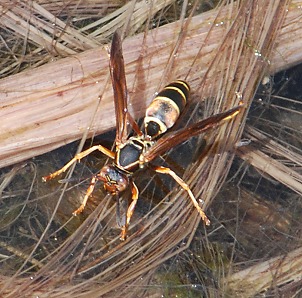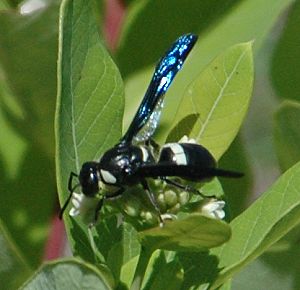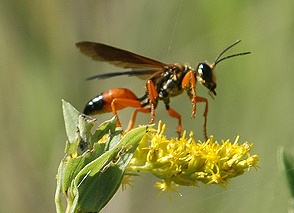We have many kinds of wasps (many more kinds than I knew existed when we moved here! I thought all black wasps were mud daubers–and there was only one kind. I thought all red wasps were hornets, and the common small yellow-and-brown striped wasp was a yellow-jacket…and that was it.)
But the scariest of our wasps, to me, was the big, multicolored wasp that seemed determined to get into the vans and then–if I didn’t get it out before starting–buzzed around busily, bumping into windows and sometimes me.
 This Northern Paper Wasp, Polistes fuscatus, is a female, perched on some rotting leaves of water iris and sucking up water to take back and cool her nest. I was quite close to her, to take the picture (though it is cropped–so not that close) and she never “buzzed” at me. Though these wasps used to terrify me, I’ve never been stung and now know that they can be gently urged out of the car or house.
This Northern Paper Wasp, Polistes fuscatus, is a female, perched on some rotting leaves of water iris and sucking up water to take back and cool her nest. I was quite close to her, to take the picture (though it is cropped–so not that close) and she never “buzzed” at me. Though these wasps used to terrify me, I’ve never been stung and now know that they can be gently urged out of the car or house.
In a wetter year, when the dogbane flowers lasted longer, we had these, still not identified for sure [Edit: yes, they were–I misplaced the reference: a mason wasp, Monobia quadridens. Publish post in haste, repent at leisure.]

These wasps show no interest in the photographer. Another handsome wasp in our area is the Great Golden Digger Wasp, Sphex ichneumoneus (the females are busy excavating the holes in which they’ll lay eggs right now, though the picture was taken later in the year:

After years of living around these and many more wasps, and realizing finally that they had lives to live that didn’t involve hunting me down to sting me, I’ve become a lot less scared of them, and a lot more interested in what those lives are like. We do still knock down the nests of the paper wasps who think the front porch corner by the utility room door (the most used of our outside doors) is the right place to nest–and then resent our going in and out. But we let them nest elsewhere, because the irritable little P. exclamans is a good control for webworms in the pecan trees.
Comment by Barb — June 22, 2009 @ 4:50 pm
Yes, why is it that wasps seem to pick the one door that you use the most for their nesting area? We have an empty floodlight fixture by our backdoor that we have to “de-wasp” at least once a year, sometimes twice.
The blue glint on the wing of the black wasp–is that a trick of the light or are they really that iridescent?
Comment by elizabeth — June 22, 2009 @ 6:11 pm
Our front porch offers a well-protected corner under a cornice in two places–ideal for the wasps, as these corners are protected against strong winds, hail, heavy rain, while offering multiple easy flight paths for the wasps. Two doors open onto the porch, each within a few feet of a corner. On a friend’s ranch, the front porch is deeper, and extends the length of the house, with the front door far from a corner, near the middle. Their wasps build away from the front door, making use of other “enclosed” structures unless the barn swallows get there first.
A lot of our paper wasp nests are in the carport, which has a pitched roof like the house; the only time we’ve had a problem was when my husband was cleaning the car’s windshield with an ammonia-containing product. He was stung repeatedly by wasps from the nest nearest the car. Now we clean the windshield outside the carport. Because of the pitched roof, these nests are higher above us than on the porch, and–if we don’t stink up the place (their concept of “stink”) they don’t bother us.
The light fixtures on our friends’ porch attract swallows as well as wasps, and the swallows apparently outcompete wasps for this prime territory.
We remove our front-porch-corner nests every spring, as soon as we notice that a wasp is building there–scrape it clean and then spray that area to deter the wasp from returning.
Several of the black wasps around here do have strong blue iridescence on the wings–quite beautiful–and one of the black wasps has that all over its body.
Comment by Chuck — June 22, 2009 @ 9:08 pm
My father, who grew up in Mississippi, always claimed that real yellow jackets have bodies a little different from the typical wasp, and they nest in the ground. (Would that make them some variety of hornet?) He always called the small yellow and brown striped wasps “Guinea wasps” — and he always claimed both the Guinea wasps and yellow jackets were more agressive than the big red wasps. I’m not sure if that was something innate, or a function of having to knock down more of the Guinea nests than the other kind, and get closer to do it since they were smaller. Of course, the fact that they were retrieving the knocked-down nests to use the grubs as fishing bait might be a factor as well. One of the horrors of my childhood was a trip to my grandpaents where we woke up to find that the nest saved for bait had mostly hatched in the night, and the room was swarming with wasps! My father and grandparents were highly amused at my refusal to come out from under the covers until the wasps had all been dispatched! My dad also once told me that he didn’t like using the insecticides that shoot a long discrete stream up at the nest, because it wasn’t very sporting.
Comment by elizabeth — June 22, 2009 @ 10:39 pm
“Guinea wasps” are apparently one of several local names for the _Polistes exclamans_ wasp in different parts of the country…and “yellow jacket” is a completely different insect up north (I learned) but in our area what you call Guinea wasps were called yellow jackets, possibly because the “real” yellow jackets didn’t exist there. (Extreme south Texas.)
Comment by Abigail Miller — June 24, 2009 @ 8:54 am
Should a chemical attack on wasps be absolutely required, I have discovered that Victor wasp killer http://www.organic-gardening-shop.com/Agorganics/product_details.aspx?ProductID=163&Pname=Wasp+%26+Hornet+Killer is quite satisfactory. Its active ingredient is mint oil, in a rather powerful concentration, which does in wasps quite as thoroughly as the assorted chlorinated hydrocarbon alphabet-soup formulae. Nests which bother me are usually in a place that I can knock them down mechanically, but the tenants in my rent house generally are not happy with such measures, so I supply them with this to encourage them not to go out and get the Orthe/Raid/Combat stuff.
Comment by Marcy — May 6, 2010 @ 2:15 pm
where i live we have alot of wasps. they can be found all over my back yard and they absolutly terrify my brother, but interest me. Ive noticed that they g around certian flowers but not others.
What i want to know is what attracts them to these flowers and why? Do they gather necter like bees?
Comment by elizabeth — May 6, 2010 @ 9:56 pm
Marcy, wasps (some of them anyway) do suck nectar, and like other insects, they have favorite “flavors.” I used to be very scared of wasps, but have come to realize that they consider me no more interesting than a moving post, and I’m now much more comfortable getting up close to photograph them. Are you familiar with BugGuide.net? It’s a huge site about insects, and I’ve learned a lot there.
Comment by Mike J — July 5, 2010 @ 1:46 pm
I am from & live in Florida. I was just trimming azaleas & got popped in the face by a big brick & black paper wasp. Didn’t seem as painful as the striped paper wasps of my youth, which are seldom seen hereabouts anymore (unmissed). I looked in my “Merck’s” & it said to put ice on it; I used some frozen hot dogs & it took the discomfort almost entirely away. Two weeks ago I was stung by some guines wasps trimming bushes, but their stings are almost negligible, discomfort-wise, to me, & I didnt even cease work.But then, I’ve been stung a lot, by a lot of critters.BTW_– I have never known anyone to be stung by a bumblebee or a mud dauber.
Comment by Frustrated by the Bees — June 29, 2011 @ 2:04 pm
How do you get rid of the black and white wasps — they seem immune to spray. And, yes, why do they love the most busy areas?
Comment by elizabeth — June 29, 2011 @ 2:33 pm
I don’t try to get rid of the black and white wasps–or any wasps, in fact, except paper wasps building a nest right by the door. The paper wasps help control webworms in our pecan trees, and Monobia, the black and white wasp in the picture, has never stung any of us. Some wasps dislike particular smells and it sets off their defensive behavior (ammonia is one: the only time the paper wasps nesting in the carport stung one of us, it was because of using an ammonia glass cleaner on a car’s windshield.)
Generally, if you let wasps alone, they’ll let you alone. (If they’re nesting too close to a door you use often, they are more likely to defend the nest, but I’ve walked past a nest a couple of feet away without being stung.) Avoid wearing strong scents (perfumes, colognes, hair spray, etc.) except for insect repellent, which they usually move a little away from.
Comment by robin lowe — July 18, 2014 @ 11:30 am
i found a wasp with a brownish body and light black stripes, well maybe a wasp it had no stinger that i could tell i was wondering what in the heck it was. can someone please tell me. its long and skinny like a wasp, just one i’ve never seen before.
Comment by oklahoma — August 16, 2014 @ 11:44 am
I knocked down a wasps nest and the next day they had put it back up. Then one t I me I knocked down a nest. It fell on my patio GROUND. . NEXT 2 days is was no longer there. How is that possible?
Comment by elizabeth — August 16, 2014 @ 4:01 pm
When you have an insect unknown to you, take a clear photo of it (as close-up as you can get) and send it to BugGuide.net. Nobody can tell from a verbal description what the species is. I’m not an entomologist but experts at BugGuide have helped me learn more about insects.
Comment by elizabeth — August 16, 2014 @ 4:02 pm
Wasps have predators. Some are particularly fond of wasp eggs and larvae and will destroy a downed nest to get at them.